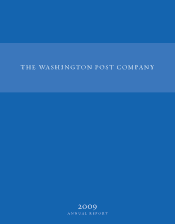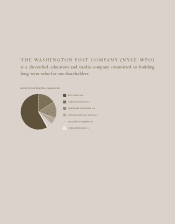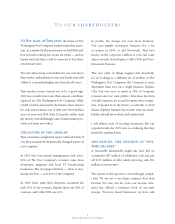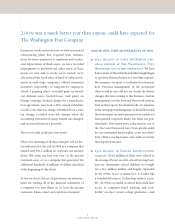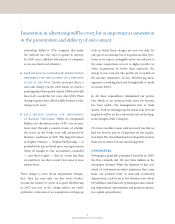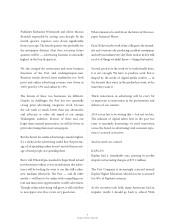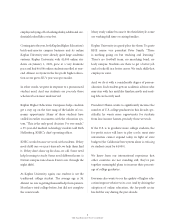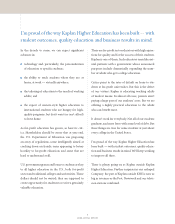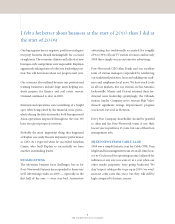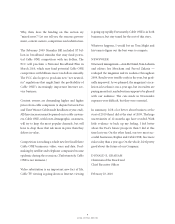Washington Post 2009 Annual Report Download - page 4
Download and view the complete annual report
Please find page 4 of the 2009 Washington Post annual report below. You can navigate through the pages in the report by either clicking on the pages listed below, or by using the keyword search tool below to find specific information within the annual report.
At the start of last year, the future of The
Washington Post Company seemed somewhat uncer-
tain. As a symbol of the uncertainty, we had $400 mil-
lion in bonds coming due in just six weeks — and no
lender had said they could be renewed at less-than-
extortionate rates.
The wise advice from our lead director was: wait about
three weeks. And indeed, new ten-year bonds were sold
(albeit at a somewhat higher rate than the old ones).
This modest success turned out to be a good sign.
2009 was a much better year than anyone could have
expected for The Washington Post Company. While
GAAP results looked awful, the balance sheet doesn’t
lie: cash and securities net of debt were $269 million
more at year-end 2009 than 12 months earlier (and
the money overwhelmingly came from business pro-
ceeds, not from asset sales).
THE NATURE OF THE COMPANY
This somewhat complicated report will read better if
you keep in mind the dramatically changed nature of
our Company.
In 1991 (the year present management took over),
82% of The Post Company’s revenues came from
newspaper, magazine and local TV broadcasting
businesses. The newspaper division — then, as now,
mostly the Post — was 47% of the Company.
In 2009, these same three divisions accounted for
only 25% of our revenues. Kaplan alone was 58% of
revenues, and Cable ONE was 16%.
In profits, the change was even more dramatic.
Our once-mighty newspaper business lost a lot
of money in 2009; so did Newsweek. That new
money in the corporate cashbox at year-end came
almost entirely from Kaplan, Cable ONE and Post–
Newsweek Stations.
This new order of things suggests that sharehold-
ers are looking at a different set of realities at The
Washington Post Company; the Company is more
dependent than ever on a single business: Kaplan.
(The Post was never as much as 58% of Company
revenues since we went public.) Education has been
a terrific business, for us and for many other compa-
nies. It should be in the future, as well. But as 2010
dawns, Kaplan’s business faces some risks our share-
holders should know about and understand.
I will address each of our large businesses. But our
reported results for 2009 were so confusing that they
should be explained first.
2009 RESULTS: THE MEANING OF “ONE-
TIME CHARGES”
A reasonable shareholder might ask: how did we
accumulate $87 million of additional cash and pay
off $155 million of debt, while reporting only $91
million of net income?
The answer to this question is astonishingly compli-
cated. We are not a very large company (less than
Fortune 500 size), but for years, our income state-
ment has offered a reference book of one-time
charges. We have closed businesses; we have sold
2
THE WASHINGTON POST COMPANY

